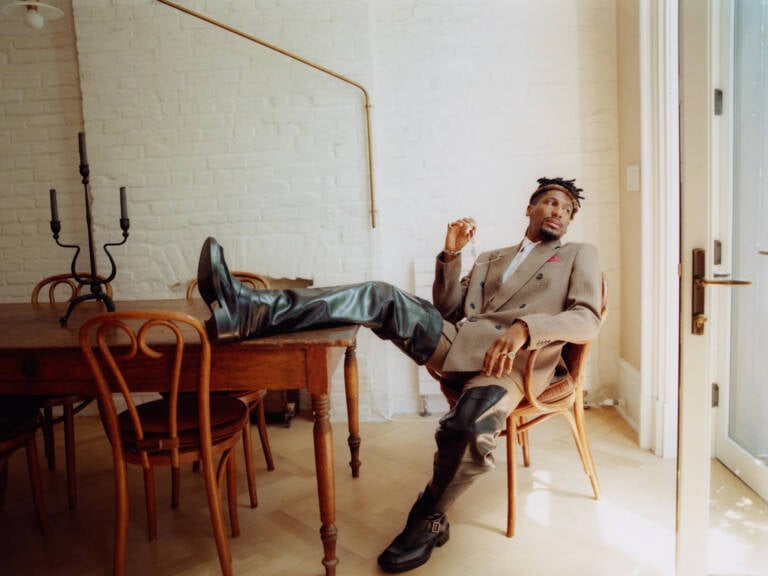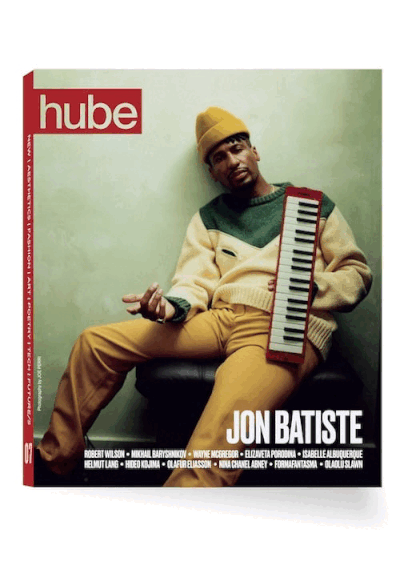“The most universal sound is silence,” Jon Batiste explains. “Room tone, nature, or the night sky. As sounds emerge from that silence, they create alignment—like the rhythm of a baby being born, a tree growing, the way life organises itself.”
For Batiste, it seems that the world has always held deep sonic resonance. Born into one of the bayou’s musical dynasties, he grew up immersed in a wash of soul, funk and jazz. By the age of eight, he was playing percussion in the Batiste Brothers Band; by seventeen, he had released an album. It wasn’t long after his graduation from Juilliard that he took up the role of Musical Director at The Late Show with Stephen Colbert. Today, the musical virtuoso—who counts Stevie Wonder, Quincy Jones, and Herbie Hancock as friends and mentors—has been awarded an Academy Award, an EMMY, a BAFTA, a Golden Globe, and multiple GRAMMYs for his work.
While his talent is undeniably prodigious, his sound defies genre—drawing from jazz, gospel, and the blues; from the lyrical intensity of protest music, the syncopated rhythms of reggae, and the melodic harmonies of folk. It is, he says, a new Americana, a “social music” created as an antidote to modern disconnection. “Music is a spiritual practice, a therapy, a way to connect us to ourselves, each other, and the divine,” he tells hube. “I want my music to inspire joy… To show not just the problem, but also the possibility.” Ahead of the launch of his new album, BIG MONEY, we sat down to discuss how art can speak to the myriad crises of our time.
hube: We are all shaped by our past. When the past remains present, we call it tradition. For some, tradition serves as a foundation; for others, it becomes a barrier to embracing the new in art. What is your relationship to legacy?
Jon Batiste: Tradition is complicated but useful. It shows us how people have dealt with life for generations, sometimes centuries, and there’s wisdom in that—but there’s always someone who comes along to make it better. I don’t look to tradition to repeat it, I look for the holes, the spaces to disrupt, and the elements that feel authentic to me. I try to learn from it, but also push against it. It’s easy to aim for disruption if you haven’t cultivated a foundation. The harder but more rewarding path is learning tradition deeply, as if you lived in that time, and then taking it further.
h: Music has the power to completely reshape the way we experience other forms of art—it can alter how we see a painting, feel a performance, or interpret a story. In your work, how do you approach this power? Do you see sound as leading, following, or engaging in dialogue with other mediums?
JB: Sound is always in dialogue. The most universal sound is silence: room tone, nature, or the night sky. As sounds emerge from that silence, they create alignment—like the rhythm of a baby being born, a tree growing, the way life organises itself. Music mirrors that. It’s ephemeral, intangible, impossible to hold in your hands, and that’s what makes it powerful. Music speaks to the unseen, to the things we can’t put into words. Ultimately, it’s organised sound, but nothing is more organised than life itself.
h: There’s something almost alchemical about music. It can bypass logic and speak directly to the heart—it’s one of the few languages that seems to understand us before we understand it. Do you ever wonder where that power comes from? Does creating music ever feel like channeling something beyond yourself?
JB: For me, music affirms the existence of God, the soul, and the unseen forces that shape our lives. Our physical bodies are just part of the equation. When we hear music, it pulls us into that other realm, even while we’re in this physical form. That’s why music isn’t just entertainment, it’s a spiritual practice. I believe it was made to inspire communion with the divine, to move us, to make us transcend what seems possible. That’s the power I feel when I create.
h: The realm of music feels boundless, it is perhaps the freest of all creative domains. How is music connected to time, and can we speak of evolution when we speak of music? Do you feel that music is progressing, or is it cycling through reinvention?
JB: Nothing in music is new, yet it’s infinite in its expression. Every soul has its own unique essence, and that’s what keeps music evolving—not the form, but the individuality. Hundreds of billions of people could exist, and no two will ever be identical. That uniqueness infuses music. The same 12 notes, the same rhythms and harmonies, but only one Kendrick Lamar, one Nina Simone. That’s why I see music as a continuum, not an evolution like technology. The real question is: how do I contribute to the continuum of human creativity?




